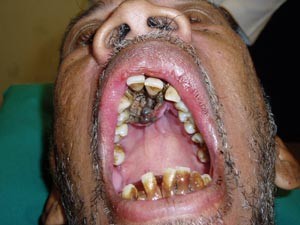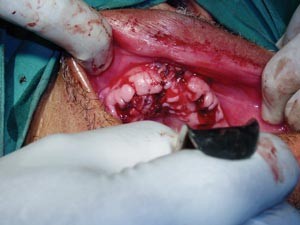Sir, recently we came across a case of oral myiasis, an extremely rare condition, and would like to share it with your readers.
Oral myiasis is caused by the larvae of the fly family sarcophagidae in wounds. Sterilised fly larvae are often used to treat stubborn non-healing ulcers by the larvae consuming necrotic tissue and leaving viable tissue behind.1
A middle-aged man (Fig. 1) attended The University of the West Indies Dental School and was a known psychiatric patient suffering from schizophrenia and depression. Although the room filled with the pungent smell of rotting flesh, he was totally unaware of what was happening in his mouth.

Several reports of oro-facial myiasis infestations have been found in the literature2,3,4,5,6,7,8. Two closely resemble our case. One was in a 20-year-old cerebral palsy female who was noted to have an upper lip swelling2 and the other in a secondarily infected noma of a 65-year-old male.3
Treatment of myiasis involves physical removal of the larvae and wound cleansing with either topical or systemic medication. Agents used have included ether, chloroform, iodoform or olive oil.2 Satisfactory results have been obtained using systemic Ivermectin.2,9
Our patient received surgical exposure of the affected area under general anaesthesia, removal of the maggots and wound debridement (Fig. 2). The wound was closed with vicryl sutures and the patient was given co-amoxiclav and metronidazole for one week. He was reviewed seven days later and a satisfactory resolution was evident.

References
- Thomas S, Jones M, Shutler S, Jones S . Using larvae in modern wound management. J Wound Care 1996; 5: 60–69.Article Google Scholar
- Elio R P, Shinohara H, Martini M Z, de Oliveira Neto H G, Takahashi A . Oral myiasis treated with ivermectin: case report. Braz Dent J 2004; 15: 79–81.Article Google Scholar
- A M M Aguiar, C O Enwonwu, F R Pires . Case report: noma (Cancrum Oris) associated with oral myiasis in an adult. Oral Dis 2003; 9: 158–159.Article Google Scholar
- Rossi-Schneider T, Cherubini K, Yurgel L S, Salum F, Figueiredo M A . Oral myiasis: a case report. J Oral Sci 2007; 49: 85–88.Article Google Scholar
- Abdo E N, Sette-Dias A C, Comunian C R, Dutra C E, Aguiar E G . Oral myiasis: a case report. Med Oral Patol Oral Cir Bucal 2006; 11: 130–131.Google Scholar
- Droma E B, Wilamowski A, Schnur H et al. Oral myiasis: a case report and literature review. Oral Surg Oral Med Oral Pathol Oral Radiol Endod 2007; 103: 92–96.Article Google Scholar
- Erol B, Unlu G, Balci K, Tanrikulu R. Oral myiasis caused by hypoderma bovis larvae in a child: a case report. J Oral Sci 2000; 42: 247–249.Article Google Scholar
- Gunbay S, Bicakci N, Canda T, Canda S. A case of myiasis gingiva. J Periodontol 1995; 66: 892–895.Article Google Scholar
- Fox L M . Ivermectin: uses and impact 20 years on. Curr Opin Infect Dis 2006; 19: 588–593.Article Google Scholar
Author information
Authors and Affiliations
- ManchesterJ. Philip
- JamaicaR. Matthews
- DurhamJ. E. Scipio